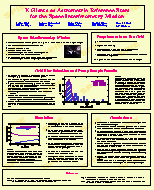K Giants as Astrometric Reference Stars for the Space Interferometry Mission
poster presented at Astronomical Telescopes and Instrumentation 2000
SPIE Conference, March 27-31 2000, Munich, Germany
Proceedings of Interferometry in Optical Astronomy,
eds. P.J.Lena & A.Quirrenbach, SPIE Vol. 4006, p. 806, 2000
Abstract
|
The Space Interferometry Mission (SIM), which is part of NASA's Origins Program
and scheduled for launch in 2006, is designed to detect extrasolar planets
using optical interferometry. The very high astrometric accuracy of a few
microarcseconds will be achieved by measuring positions relative to a grid of
about 3000 reference stars distributed uniformly over the sky.
Here we follow an approach exploring the properties of Hipparcos and Tycho K giants as possible grid star objects. We searched both catalogues for grid candidate K giants using 17 different selection criteria, ensuring that every possible multiple or variable star was rejected. We then observed the very brightest stars of this sample several times with the Coude Auxiliary Telescope at Lick Observatory using the Hamilton Echelle Spectrograph in conjunction with the iodine cell, yielding very precise radial velocities for these stars. This helps us to identify so far unknown double or multiple stars among our sample. The statistical results of this project can be used to demonstrate the suitability of K giants as grid stars in general as well as to estimate and specify the amount of effort needed to perform the whole grid star task, including the demonstration of its feasibility. |
| scaled down version (about DIN A4 or letter size)
[poster (637 kb)]
| |

 link collections
link collections